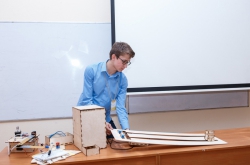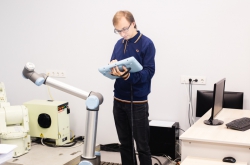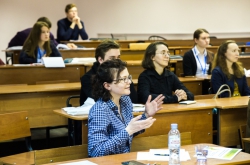RoboFinist is an international festival that aims to bring together like-minded robotics enthusiasts, facilitate the development of talented youth and promote robotics and creative science. The event is organized by the Charity Foundation Finist, Lyceum №239 and the company StarLine.
According to the organizers, this year’s festival drew more than a thousand of both young and old robotics enthusiasts and teachers from all over Russia, as well as from Kazakhstan, Cyprus, Croatia, Turkey and Brazil. Teams competed in such categories as “Line Follower”, “Lego Sumo” and “Humanoid Sumo”, “Marathon”, “Relay Race”, “Arkanoid” and many others. The program also included robotics quizzes, workshops and a creative project exhibition.

At ITMO University’s area, visitors could meet robots, complete quests and look for “Star Wars” characters in a hologram. The Student Lab OLIMP had a childrens’ robotics booth set up, while ITMO’s FabLab offered guests an opportunity to draw using next-gen 3D pens, use a 3D scanner or meet a robotic Sorting Hat from the “Harry Potter” series.
In the VR/AR area, visitors took part in a space-themed quest developed by Master’s students from the Department of Engineering and Computer Graphics. ITMO’s Museum of Optics demonstrated the work of leap-motion technology that allows players to use their hands and fingers as input sources in virtual reality. Those who brought a flashlight could entertain themselves with Star Wars-themed regular and Scratch holograms.

How to teach robotics
As part of the festival’s business program, a symposium on educational robotics was held for robotics teachers from all over Russia. Educators from Moscow, St. Petersburg, Novosibirsk, Orenburg and other cities shared their best practices and discussed the ways to get children interested in engineering and how to properly teach robotics in schools.
According to Oleg Gorelov, professor at Moscow City University, robotics courses for young schoolchildren should account for several basic elements that, together, should prepare children for project work conditions. There is nothing scary about letting children learn the basics of programming starting with the second grade: as practice shows, most children of that age are able to comprehend the basic principles, such as branching and cycles.

On the other hand, even if the child isn’t very good at programming, it doesn’t mean that they can’t get into robotics. A course should include elements involving work with analog sticks and button controls, which lets children, once they’ve grasped the basics of programming, create their first projects. Even if they’re unable to write complex functions, they can still become apt engineers.

Another important aspect of knowledge for children studying robotics are the basics of graphic design, believes Anna Korotkova, educator at the Genesis Center of Innovative Creativity (Novosibirsk). There, children learn not only about programming and 3D modeling, but also about creating mock-ups and designing robots.
“Robotics is, of course, a multi-faceted area where you need to possess varied knowledge and know how to create projects. Yet, children need to be able to go beyond the limits of educational construction toys and the like. To do that, they need to understand how they can design their own robots, how to put all the components in one body and how to keep it functional, yet stable. This is when their design skills come in handy, helping them figure out how to create such structures. These kinds of things are taught to professional designers and architects, and we suggested introducing some of them into robotics courses for children,” – says the expert.

Today’s 12 year-olds are already able to program and assemble microcontroller units, but they don’t have access to frames in which to apply them. For that reason, it is necessary to teach them, starting with elementary school, the basics of academic and technical drawing, as well as the use of simple graphic editing software in order to help them develop spatial thinking and avoid trouble when studying geometry. Yet it’s not enough to focus on 3D modeling only, says the teacher: children also need to be taught the basics of material science to help them better choose the materials for their future creations.





